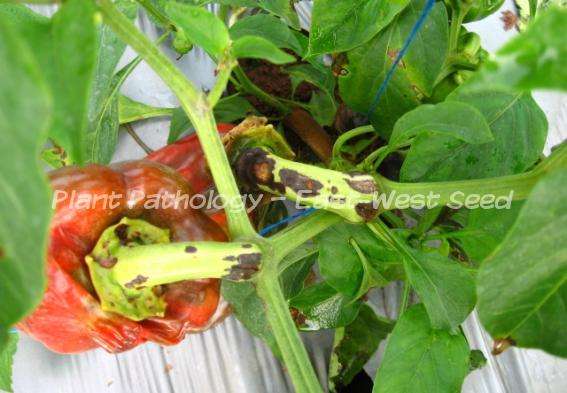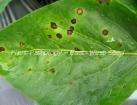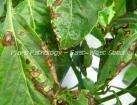Causal Agent:
Bacterium (Xanthomonas spp.)
| Characteristic Symptoms: | |
 |
Leaf lesions begin as small, brown, water-soaked spots, which turn brown and become necrotic at the center. |
 |
Under high humidity conditions, numerous lesions may coalesce giving the plant a blighted appearance. |
 |
Fruit lesions begin as circular green spots, which later enlarge and turn brown with rough and wart-like appearance. |
| Conditions for Disease Development: | |
 |
The pathogen is seed-borne and is capable of overwintering on plant debris in the soil and on volunteer host plants in abandoned fields. |
 |
Bacteria invade the plant through stomata on the leaf surfaces and through wounds on the leaves and fruit caused by abrasion from sand particles and/or wind. |
 |
Temperatures between 24-30°C and prolonged periods of high relative humidity favour infection and disease development. |
 |
The bacteria is spread by windblown rain, overhead irrigation, drainage of infested water, by mechanical means (handling of infected seedlings, on contaminated tools) and by workers (on hands, clothing). |
| Management and Control: | |
 |
Use resistant varieties, if available. |
 |
Use pathogen-free seeds and seedlings as the disease is difficult to control once introduced in the field.
|
 |
Avoid working in affected areas when leaves are wet to minimize spread. Disinfect tools with10% household bleach (chlorox) after working in infested area. |
 |
Avoid overhead irrigation. Rain shelters in seedbeds may help reduce rain splash and disease severity.
|
 |
Practice 2-3 years rotation with non-host crops.
|
 |
Apply copper or copper+mancozeb sprays on dry seedlings prior to transplanting and continue at 5 days interval.
|
| References: | |
| AVRDC Factsheet. AVRDC Publication 04-572 (2004) at www.avrdc.org; Compendium of Pepper Diseases (2003) by APS; Bacterial Spot of Tomato and Pepper at http://www.apsnet.org/edcenter/intropp/lessons/prokaryotes/Pages/Bacteri... | |
To view other diseases, click here.
Need more help? Ask the Doctor.










